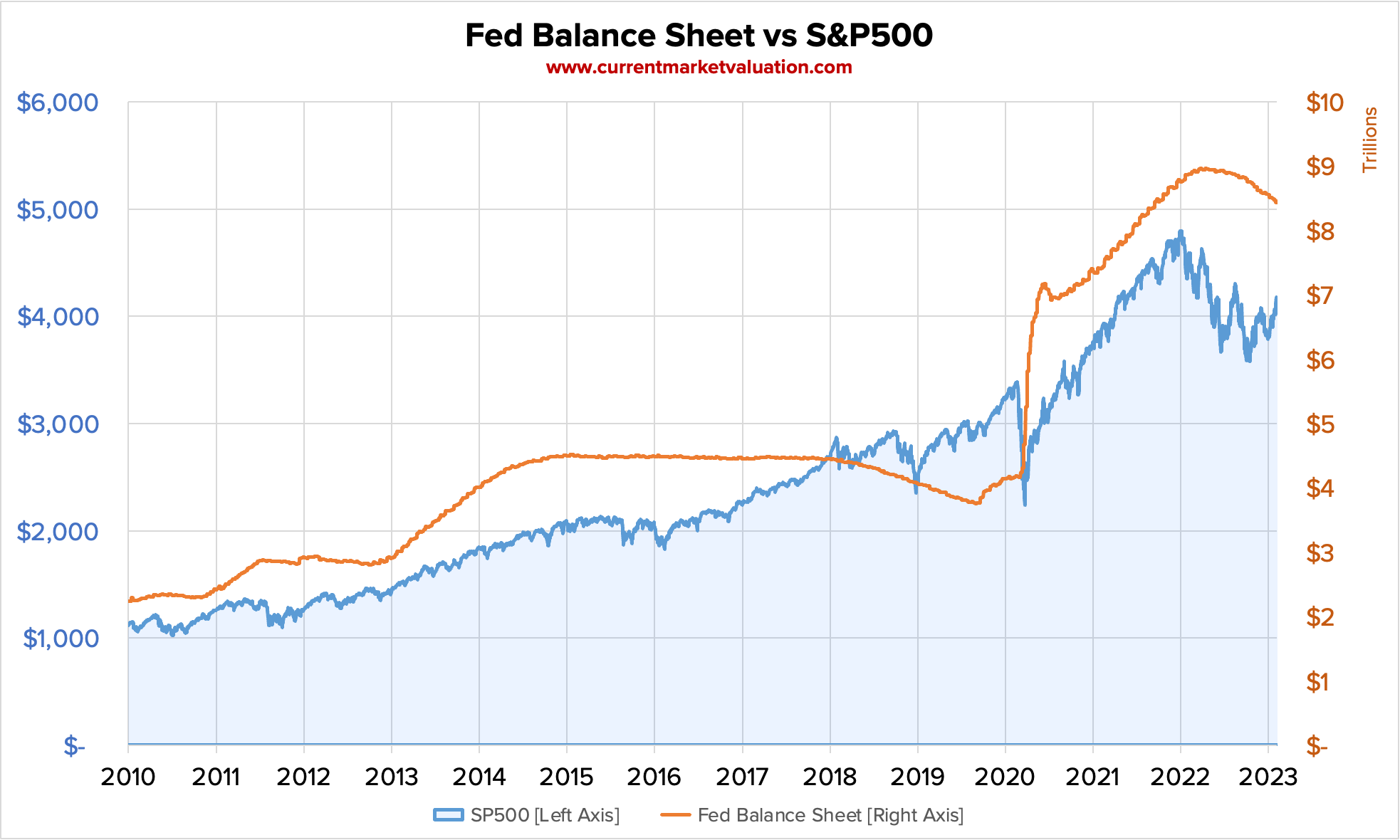
Overview
The balance sheet of the Federal Reserve (shown on right axis) has increased very substantially in 2020, continued at a steady pace throughout 2021, and has slowly declined a bit in 2022/23. After the Fed cut short term interest rates to zero, there were very limited amount of actions they could take to further juice the economy. Quantitative Easing (QE) is one such action. By expanding its own balance sheet (by buying bonds and other securities, and therefore injecting money into the economy), the Fed floods the economy with additional cash, keeping interest rates low and propping up equity markets. For additional information on the relationship between interest rates and stock market prices, see our model on interest rates.

Quantitative Easing
The Federal Reserve first began expanding their balance sheet with quantitative easing in November 2008, in response to the global financial crisis and the subsequent economic collapse. The goal of QE was to stimulate economic growth and combat deflation by increasing the supply of money and lowering interest rates beyond what the regular monetary policy tools of the time could do.
The Fed implemented QE by purchasing large quantities of long-term securities, such as Treasury bonds and mortgage-backed securities, from banks and other financial institutions. By buying these securities, the Fed increased the demand for them and lowered their yields, which in turn lowered long-term interest rates. This was a new tool to target the long end of the yield curve, whereas previously the Fed primarily affected the short end of the curve by manipulating the Federal Funds rate. All this was intended to stimulate borrowing and investment, leading to increased economic activity, job creation, and higher stock prices.
Additionally, the continuous and aggressive monetary expansion policy necessarily puts pressure on inflation. Via QE, the Fed is injecting new money into the economy. To the extent that the surrounding economy uses the money productively, and grows accordingly, that may not be a bad thing. But excess cash, all else equal, will drive up prices. In 2021, inflation has seen a rapid increase. The Fed has maintained that the increase in inflation is a "transitory" event, i.e., a temporary bump due to pandemic stimulus and post-pandemic consumer demand increases. Time will tell.
Recent Increases
The Feb balance sheet remained large throughout the 2010's. When the Covid-19 pandemic began in early 2020, short term interest rates were already at 0%, so the only available option for the Fed to prop up the economy was continued quantitative easing. The Fed balance sheet almost doubled over the following year, reaching a peak of about 9 trillion USD. The S&P500 tracks very cleanly against these increases in the Fed balance sheet.
Valuation Implications
The Fed's balance sheet expansion in early 2020 very clearly aligns with the S&P500 crash and subsequent recovery. In one sense, this suggests that the economy isn't actually doing as well as the S&P500 suggests, and raises serious concern over the sustainability of the current stock market performance. It seems like the stock market is being held aloft by aggressivly expansionary Fed policy. If the Fed ever pulls off the gas a little bit, or runs out of tools to use, or is hemmed-in by a more conservative congress, is the stock market going to crash?
On the other hand, it's a bit absurd to try and determine the 'value' of the stock market excluding the impact of the Federal Reserve. The Fed is the US Government, and is obviously part and parcel with the performance and health of the US economy. While the Fed has dramatically ramped up its activity in the last 20 years, it has also led to a very long period of relative economic stability.
Data Sources
The below table cites all data and sources used in constructing the charts, or otherwise referred to, on this page.
